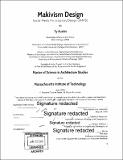| dc.contributor.advisor | Takehiko Nagakura and Ceasar McDowell. | en_US |
| dc.contributor.author | Austin, Ty (Roydrick Tyrone) | en_US |
| dc.contributor.other | Massachusetts Institute of Technology. Department of Architecture. | en_US |
| dc.date.accessioned | 2018-10-15T20:22:40Z | |
| dc.date.available | 2018-10-15T20:22:40Z | |
| dc.date.issued | 2018 | en_US |
| dc.identifier.uri | http://hdl.handle.net/1721.1/118500 | |
| dc.description | Thesis: S.M. in Architecture Studies, Massachusetts Institute of Technology, Department of Architecture, 2018. | en_US |
| dc.description | Cataloged from PDF version of thesis. "June 2018." | en_US |
| dc.description | Includes bibliographical references (page 60). | en_US |
| dc.description.abstract | We live in a world today where instantaneous transparency is the rule of thumb. Social media platforms such as Facebook or Linkedin have become the primary modes of communication and connectivity amongst professional and personal circles. Building Information Modeling, or BIM, is a 3D parametric modeling software. BIM visually assists architecture and engineering design teams remotely collaborate, innovate, and connect instantaneously with colleagues clients in more productive ways to create efficient construction projects. However, BIM's strengths in efficient transparency are often not extended to the principal stakeholders of any project: the community. This thesis will examine an intersectional interest known as Social Media Participatory Design (SMPD) or Makivism Design. SMPD is the integration of both 3D parametric modeling with social media. Network platforms, such as Facebook or Linkedin, are the primary modes of communication and connectivity amongst design professionals and community leaders today. By implementing SMPD into the built environment sector, community stakeholders can attain instantaneous access into the design process of a project through their favorite social media app. The primary research objective of this thesis is examine whether SMPD provides the designer, or user, the knowledge and communication they need to make the informed, transparent and inclusive design making decisions needed to collaborate on community-based projects. We will determine whether SMPD has the potential to empower those who feel marginalized and demand designers and clients alike to be more inclusive. | en_US |
| dc.description.statementofresponsibility | by Ty Austin. | en_US |
| dc.format.extent | 60 pages | en_US |
| dc.language.iso | eng | en_US |
| dc.publisher | Massachusetts Institute of Technology | en_US |
| dc.rights | MIT theses are protected by copyright. They may be viewed, downloaded, or printed from this source but further reproduction or distribution in any format is prohibited without written permission. | en_US |
| dc.rights.uri | http://dspace.mit.edu/handle/1721.1/7582 | en_US |
| dc.subject | Architecture. | en_US |
| dc.title | Makivism design : Social Media Participatory Design (SMPD) | en_US |
| dc.title.alternative | Social Media Participatory Design (SMPD) | en_US |
| dc.type | Thesis | en_US |
| dc.description.degree | S.M. in Architecture Studies | en_US |
| dc.contributor.department | Massachusetts Institute of Technology. Department of Architecture | |
| dc.identifier.oclc | 1054602165 | en_US |
